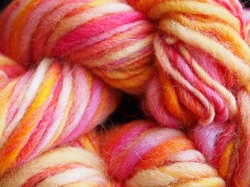
So when you hear the word Shetland do you think of small ponies and dogs that look like mini-Collies? Windswept islands? Lace? I think of lace first (because I love knitting lace) and then I think of sheep. Like the miniaturized version of horses and dogs that inhabit the Shetland Islands, the sheep are also smaller too, topping out at 125 pounds. For comparison, my friend’s St. Bernard dog weighs more at 140 pounds.
The breed is old, and retains many other historical characteristics besides size, most notably color. Where many sheep breeds have been bred to be large flocks of white to be sold to the textile industry, Shetland sheep still come in a rainbow of earthy colors- from creams, browns, grays, blacks, and all color in-between. Traditional names like emsket, shaela, mioget, and moorit are still regularly used. Shetland sheep came in single or double coat, or a wavy coat. It is soft. Staple length of the fleeces I have spun have ranged from 3-7 inches long. Below is some pictures of fleeces I have worked with throughout the years and I never have got a coarse fleece. I’ve also worked with all three types- I don’t prefer one over another. I don’t separate the double coat fleece, I just combine the two either just by fluffing by hand or carding, and spin.
You can also get Shetland roving in several colors from a variety of sellers such as the Woolery, Paradise Fibers, and Bountiful Spin and Weave. Roving is prepared fibers. It is combed into a ropelike.. well.. rope and ready to spin. I find it easier to spin if I separate the rope into several strips, about ½ inch wide. The roving comes in brown, gray, and white.
I love spinning Shetland wool, hence the “Favorite Fibers” title. I love the range of colors and it is always reliably soft. I mentioned above where I get roving. I have got fleeces from sellers on Ebay and Etsy. There are also farms whose info is in the classifieds section of Spin Off Magazine. I have an oatmeal Shetland fleece that I am washing right now and will be spinning soon, so update to come!
Below is a sampling of the Shetland handspun yarns I have created through the years.
The breed is old, and retains many other historical characteristics besides size, most notably color. Where many sheep breeds have been bred to be large flocks of white to be sold to the textile industry, Shetland sheep still come in a rainbow of earthy colors- from creams, browns, grays, blacks, and all color in-between. Traditional names like emsket, shaela, mioget, and moorit are still regularly used. Shetland sheep came in single or double coat, or a wavy coat. It is soft. Staple length of the fleeces I have spun have ranged from 3-7 inches long. Below is some pictures of fleeces I have worked with throughout the years and I never have got a coarse fleece. I’ve also worked with all three types- I don’t prefer one over another. I don’t separate the double coat fleece, I just combine the two either just by fluffing by hand or carding, and spin.
You can also get Shetland roving in several colors from a variety of sellers such as the Woolery, Paradise Fibers, and Bountiful Spin and Weave. Roving is prepared fibers. It is combed into a ropelike.. well.. rope and ready to spin. I find it easier to spin if I separate the rope into several strips, about ½ inch wide. The roving comes in brown, gray, and white.
I love spinning Shetland wool, hence the “Favorite Fibers” title. I love the range of colors and it is always reliably soft. I mentioned above where I get roving. I have got fleeces from sellers on Ebay and Etsy. There are also farms whose info is in the classifieds section of Spin Off Magazine. I have an oatmeal Shetland fleece that I am washing right now and will be spinning soon, so update to come!
Below is a sampling of the Shetland handspun yarns I have created through the years.

 RSS Feed
RSS Feed
